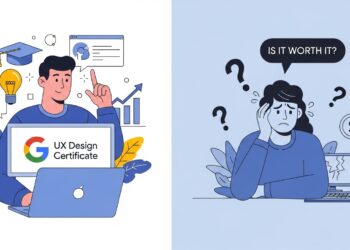UX design jobs keep growing. More apps, more sites, more need for simple, clear design. But with so many courses, which one should you choose? If you’re a beginner, the google ux design certificate on Coursera looks great. It is well-known, low-cost, and flexible. But is it right for you? In this friendly guide, we will walk through the pros, cons, costs, and the real value. You’ll see who should take it, who should skip it, and what to do next. This is for career changers, students, and busy pros who want a clear, honest look at this path.
What Exactly is the Google UX Design Certificate?
The google ux design certificate is a beginner-friendly, online program on Coursera. It was created by Google employees to prepare you for entry-level UX roles. It is self-paced and made to fit busy lives. Most learners finish in about six months and complete seven core courses with 200+ hours of content, including Figma, UX research, and responsive design. You learn by watching short videos, doing hands-on tasks, and building real projects for your portfolio. Many learners like the flexible pace, but note there is limited structured mentorship and peer feedback can be hit-or-miss. The monthly Coursera price is budget-friendly compared to long bootcamps.

Breaking Down the Key Advantages (The Pros)
Accessibility and Beginner-Friendliness in the google ux design certificate
No design degree? No problem. This program welcomes total beginners. It is 100% self-paced, so you can learn at night, on weekends, or during lunch breaks. The lessons use simple language and walk you through core UX steps like research, wireframes, and testing. Reviewers praise the flexibility, beginner focus, and clear structure for entry-level preparation. Backed by Google, it is also easy to start and stick with, making it a friendly first step into UX.
A Project-Based, Portfolio-Focused Curriculum
You learn by doing. The google ux design certificate guides you through real tasks, from research to prototypes, so you can finish with three or more projects. These projects become your starter portfolio, which you need for job applications. The focus on practical tasks and portfolio outcomes is a major plus for beginners, and many reviews highlight that hands-on practice is the big value driver. You won’t just get a paper certificate, you’ll have work you can show to hiring managers.
The Power of a Recognizable Name on Your Resume
The word “Google” stands out. Recruiters scan fast. A known name can help your resume get a closer look. While the name alone does not win a job, it can boost trust long enough for someone to click your portfolio link. Many learners choose this program because the brand is strong and the content is accessible and clear. Still, remember: the real star is your portfolio and your ability to explain your design choices.
Cost-Effectiveness Compared to Alternatives
Bootcamps and degrees can cost a lot. The Coursera subscription is a low monthly fee, so the total is often far less than big programs. This makes the google ux design certificate a smart choice if you want a strong start without big debt. Since the program is self-paced, faster learners may finish sooner and save more. For budget-minded beginners, this is a key benefit.
The Potential Drawbacks to Consider (The Cons)
The Theoretical vs. Practical Application Gap in the google ux design certificate
Yes, you do projects. But most projects are for practice, not for real clients. That means you may miss real-world limits, messy feedback, and tight deadlines. Also, peer reviews can vary, and there is no built-in mentorship, which some learners wish they had. You’ll likely need extra practice, internships, or volunteer work to get that real-world feel.
The “You Get Out What You Put In” Dilemma
This is a self-paced course. That is great for freedom, but tough if you struggle with focus. No teacher is checking in daily. You must keep a schedule, ask for feedback, and push your own work forward. The program is set up for beginners to succeed, but it still needs steady effort week by week. If you build strong habits, the google ux design certificate can work very well for you.
Market Saturation and Standing Out
This certificate is popular. Many people take it. So the certificate by itself won’t land a job. It is not a guarantee in a busy job market. To stand out, you need strong projects, clear case studies, real user feedback, and a story about your process. It’s still a great option for beginners, but it’s no longer the only good path to UX.
Limited Depth in Certain UX Specialties
The curriculum covers many basics: research, wireframes, prototypes, and Figma. But it does not go deep into advanced UX research, complex interaction design, or design systems at scale. These topics often need extra courses, mentorship, or on-the-job learning beyond the google ux design certificate.

Who is The Google UX Design Certificate Ideal For?
This program is a perfect fit for certain people. It is ideal for:
Career Changers: If you’re in a completely different field and want to break into tech, this is your roadmap.
Students and Recent Grads: It’s a great way to build practical skills that many college degrees don’t teach.
Adjacent Professionals: If you’re already in marketing, graphics, or front-end development, this certificate helps you add UX skills to your toolbox.
The Curious and Budget-Conscious: If you want to try UX without a huge financial risk, this is the best way to do it.
Who Might Want to Consider Other Options?
This certificate might not be the best choice for you if:
You are already an experienced designer looking for advanced, specialized training.
You know you struggle with motivation and need a live, instructor-led class to keep you accountable.
You need a credential from a well-known university.
The Verdict: So, Is It Worth Your Time and Money?
So, is the Google UX Design Certificate worth it? For most beginners, the answer is a strong yes.
It is an excellent, affordable, and thorough introduction to the world of UX design. It gives you the foundational knowledge and, most importantly, the portfolio projects you need to start applying for jobs.
Just remember: the certificate itself won’t get you hired. It is the skills you learn and the portfolio you build that will open doors. Think of this program as your launchpad. It gives you the fuel and direction to start your journey. The rest is up to you.
Next Steps After the Certificate
Your learning doesn’t stop when you earn your certificate! To turn your new certificate into a career, you need to take action.
Polish Your Portfolio: Make your case studies the best they can be. Tell the story of your design decisions.
Network: Connect with other designers on LinkedIn and Twitter. Join online communities. Ask for advice.
Learn More: Dive deeper into an area that interests you, like UI design or UX writing.
Start Applying: Don’t wait until you feel “100% ready.” Apply for junior roles and internships today.
Ready to start your journey? Click here to explore the Google UX Design Certificate on Coursera and begin building your future in UX design today!








